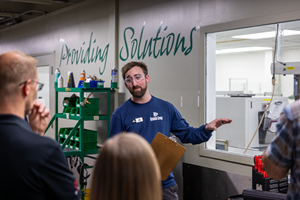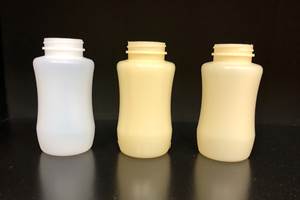TPO and PP Advances Benefit Auto Parts and Food Packaging
Polypropylene and PP-based TPO elastomers were the star players of two recent conferences on polyolefins. "TPOs in Automotive '98," sponsored by Executive Conference Management, Plymouth, Mich., featured the latest materials, modifiers, and stabilizer additives for hard and soft interior and exterior automotive applications. "SPO '98," sponsored by Schotland Business Research, Inc., Skillman, N.J., highlighted developments in high-flow PP for thin-wall injection molded packaging.
TPOs in the driver's seat
As auto makers gravitate toward PP-based materials for parts such as instrument panels, door panels, fascias, and trim, new generations of PP and TPO are being developed at a rapid pace.
For instance, Montell Polyolefins, Wilmington, Del., reported on developments in both soft olefinic skins and rigid substrates for door and instrument panels. Montell is working on a family of soft TPO skin materials that can be extruded or calendered and then thermoformed, injection overmolded on a rigid support, or slush molded. Though Montell did not impart any details on these materials, it had more to say about rigid substrate materials. The 1998-99 Ford Taurus/Sable door panel uses a newly developed 70-MFR resin as the substrate. Hifax BB746B mineral-filled PP copolymer has a flex modulus of 232,000 psi and is designed for low-pressure injection molding with a TPO skin placed in the closed mold. This method avoids the need for adhesives to bond the skin and substrate.
Montell also reported on a new 9-MFR reactor-grade TPO with 120,000-psi modulus used for the lower B pillars and scuff plates of the 1999 Ford Econoline and Lincoln Continental Town Car. These are the first commercial applications of Pro-Fax SK527, a Spheripol-process resin that is also said to be the first in-reactor TPO to meet Ford's stringent low-temperature impact specification. This test requires that the pillar will not crack when a 10-lb ball is dropped on it from 6 ft at -30 C.
Solvay Polymers, Houston, discussed two new grades of compounded TPO designed as alternatives to plasticized PVC for soft interior skins. Dexflex 250 and 280 are extrudable materials with Shore D hardnesses of 41 and 33, respectively.
A new type of modifier for TPO soft skins was presented by DuPont Co., Wilmington, Del. DuPont's "ETP" (elastomeric thermoplastic) modifier is an alloy of Surlyn ionomer and Elvaloy epoxy-functionalized ethylene copolymer. ETP reportedly imparts higher melt strength, allowing for improved thermoformability and grain retention. ETP-modified TPO has been used commercially in Europe and Brazil on the Opel Vectra since 1995 and on the Saab 9000 since 1996. ETP-modified TPOs are also being evaluated for overmolded soft-touch grips.
Making TPOs look good
Three companies at the meeting reported on advances in resins and additives to improve paintability or molded-in color stability.
Exxon Chemical, Co., Houston, reported that modifying TPOs with metallocene-based plastomers instead of conventional rubbers does more than improve low-temperature impact and flowability: Plastomers may also improve paint adhesion. Exxon offers a new commercial grade of plastomer-modified TPO aimed at fascias. Escorene PP8213 is a low-modulus compound (100,000 psi) based on a reactor-grade impact copolymer and the company's Exact plastomer. Stiffer grades with modulus in the range of 170-190 kpsi will soon be available.
Solvay has pursued a different avenue. It has commercial grades of new conductive TPOs that were developed in collaboration with Ford Scientific Research Laboratories, Dearborn, Mich. The new grades are said to dramatically improve transfer efficiency, edge coverage, and "wrap" in electrostatic painting. Use of special conductive carbon blacks and compounding techniques is said to impart these benefit without sacrificing the TPO's mechanical properties or flowability (see Table 1). As compared with standard TPOs, Solvay's new conductive compounds reportedly result in less paint buildup on fixtures, as well as less dust-attracting static on parts.
Where molded-in color substitutes for paint, uv stability is essential to keep a TPO part looking good. Ciba Specialty Chemicals Corp., Tarrytown, N.Y., recommends new stabilizer packages that provide better color and gloss retention than standard combinations of phenolic antioxidant and HALS uv stabilizer. In accelerated weathering tests (see graph), better overall performance was obtained with a combination of three of Ciba's newest products: Irgastab FS 042 dialkyl hydroxyl-amine antioxidant; Tinuvin 123, a low-molecular-weight, monomeric, NOR-type HALS; and either Chimassorb 2020 or CGL 116, both high-MW, non-interactive HALS.
New PPs for thin walls
New catalyst systems are spawning high-flow polypropylenes for thin-wall injection molded packaging, according to papers presented at SPO '98 by Exxon and Montell.
Low extractables and good stiffness/clarity balance have made Exxon's Achieve metallocene-catalyzed isotactic polypropylene (mPP) attractive for thin-wall food packaging. It is also finding use in specialty electronics and medical packaging.
As shown in Table 2, Achieve mPP with a clarifier has advantages over conventional clarified homopolymer and random copolymer of similar MFR in both mechanical and thermal properties and in clarity.
Exxon reports that when mPP is copolymerized with ethylene, even lower haze levels are achieved, while superior stiffness is retained. This could allow mPP to compete with more costly clear amorphous polymers like TP polyester and polycarbonate.
Montell is developing a new non-metallocene, Ziegler-Natta catalyst system that reportedly can produce a 100-MFR heterophasic PP copolymer right in the reactor (without subsequent "controlled-rheology" treatment). Montell sources say this would be a significant leap beyond 35-MFR ("as-polymerized") heterophasic copolymers. Work so far shows these materials could permit thin-walling injection molded containers down to 0.014 in. or less. Montell will make such copolymers from a commercial facility in the second quarter.
Related Content
Medical Molder, Moldmaker Embraces Continuous Improvement
True to the adjective in its name, Dynamic Group has been characterized by constant change, activity and progress over its nearly five decades as a medical molder and moldmaker.
Read MoreWhat to Look for in High-Speed Automation for Pipette Production
Automation is a must-have for molders of pipettes. Make sure your supplier provides assurances of throughput and output, manpower utilization, floor space consumption and payback period.
Read MoreHow to Extrusion Blow Mold PHA/PLA Blends
You need to pay attention to the inherent characteristics of biopolymers PHA/PLA materials when setting process parameters to realize better and more consistent outcomes.
Read MoreMedical Tubing: Use Simulation to Troubleshoot, Optimize Processing & Dies
Extrusion simulations can be useful in anticipating issues and running “what-if” scenarios to size extruders and design dies for extrusion projects. It should be used at early stages of any project to avoid trial and error and remaking tooling.
Read MoreRead Next
For PLASTICS' CEO Seaholm, NPE to Shine Light on Sustainability Successes
With advocacy, communication and sustainability as three main pillars, Seaholm leads a trade association to NPE that ‘is more active today than we have ever been.’
Read MoreBeyond Prototypes: 8 Ways the Plastics Industry Is Using 3D Printing
Plastics processors are finding applications for 3D printing around the plant and across the supply chain. Here are 8 examples to look for at NPE2024.
Read More












